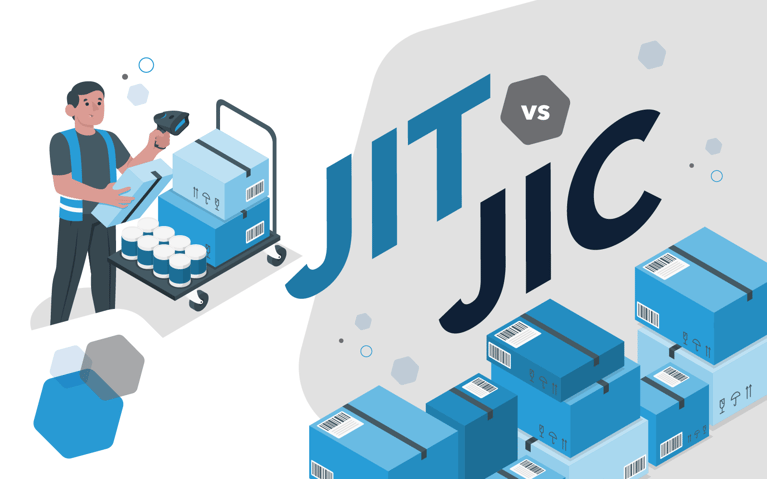Originally published October 6, 2022, updated March 19, 2024 by A.Wolfe.
It’s easy to underestimate the importance of inventory management. It’s a critical component of order management and must be done properly for your retail business to run smoothly. The numbers tell all: A high inventory turnover rate shows that your business consistently uses the inventory in stock. Conversely, a poor inventory turnover rate can cause unsold stock and indicates gaps in your inventory management.
Whatever your results, your business should always try to manage inventory levels as efficiently as possible. Efficient inventory management is crucial for businesses to meet customer demand while minimizing costs. Maintaining optimal inventory levels prevents stockouts, ensuring that products are always available when customers want them. It also reduces excess inventory, which ties up capital and incurs storage costs. By managing inventory efficiently, businesses can:
- Reduce risk. Your inventory is one of the most valuable assets for your business. It’s also vulnerable to damage and theft. The proper inventory levels mitigate these risks.
- Improve customer satisfaction. Customers, especially modern customers, don’t want to wait for their items. Shipping delays due to stockouts hurt your customers and brand reputation. Improved inventory management can prevent these stockouts and boost customer satisfaction.
- Increase cash flow. When you hold excess inventory, you’re unnecessarily tying up your resources. Changing your inventory management so you only bring in stock that you’ll use or sell will keep cash moving through your business.
Managing your inventory levels using robust inventory management solutions will improve your business both operationally and financially. But first, you must address any inventory management challenges.
Common inventory challenges that businesses face
There’s a wide variety of inventory challenges your business might face, which can lead to stockouts, causing lost sales opportunities and customer dissatisfaction. Challenges can also cause overstock, which ties up capital and storage space, increasing carrying costs and the risk of obsolescence. Poor inventory management can result in inaccurate forecasts, leading to overstocking or understocking of products. In addition, inefficient inventory processes can strain operational efficiency and hinder scalability for growing businesses. Here are four common inventory management challenges to watch for:
Incorrect data
As an example, suppose your inventory records indicated that you have plenty of one of your business’s most popular products in stock. You would list this product as available, and orders would keep rolling in. But those inventory counts were wrong – you have extremely low stock of the product. At that point, your customer service would need to reach out to customers to let them know the product they ordered is now out of stock. Customers would complain. Your brand reputation would take a hit, which are just a couple of the pitfalls of having incorrect inventory data. Any inaccuracies in your data can lead you to make decisions based on bad information. Plus, having to correct inaccurate information about stock levels wastes precious time and resources.
Tracking discrepancies
Some businesses use different spreadsheets and software as part of a manual inventory tracking process. Not only is this inefficient and time-consuming, but physical counts are also prone to producing tracking discrepancies. Some causes of inventory discrepancies are:
- Theft
- Losing items in the distribution facility
- Faulty returns processing
- Damage
- Supply chain glitches
You never want to have two (or more) contradictory records of what you have in your inventory. You’ll have to investigate which record is accurate if you encounter these tracking discrepancies.
Fluctuating customer demand
Customer demand changes constantly, and businesses are left scrambling to make new forecasts. Fluctuating inventory demand can be caused by seasonal variations, changes in consumer preferences and market trends. External factors such as economic conditions, competitor actions and unforeseen events like natural disasters can also impact demand levels. Additionally, promotional activities, product launches and supply chain disruptions can contribute to fluctuations in customer demand.
If you overestimate customer demand, you may end up with obsolete inventory that you can’t sell taking up storage space. However, if you underestimate demand, your business will experience costly stockouts. Part of inventory management is finding a solution to execute demand forecasting as accurately as possible – which is easier in the age of artificial intelligence (AI). You should adjust your inventory levels accordingly when your forecasts predict increases or decreases in consumer demand. The more accurate your demand forecasts are, the better your business will be equipped to meet that demand without impacting your bottom line.
Poor warehouse organization
A poorly organized warehouse and layout can lead to inefficient space utilization, making it difficult to locate and access inventory quickly. This can result in longer picking times, increased labor costs and higher risk of errors such as stockouts or overstocking. Additionally, it may hinder inventory visibility and accuracy, leading to challenges in inventory management and fulfillment efficiency. In addition to improving warehouse layout in a way that better supports inventory management, consider developing a new inventory management strategy using best practices to optimize your entire retail operations.
Inventory management best practices you should follow
Using inventory management best practices is crucial for optimizing operations, minimizing costs and maximizing profitability. These practices help ensure accurate inventory levels, streamlined processes and efficient use of resources. By adhering to best practices, businesses can enhance customer satisfaction, reduce stockouts and improve overall supply chain performance. Here are eight inventory management best practices to implement today:
1. Use an inventory management software system
Gone are the days of having to do all your inventory management manually. Today, you can use inventory management software to track and manage your inventory. Inventory management software is a tool for automating your inventory management system. The software tracks your inventory and automatically updates your inventory records when you make a sale. You can also set the software to create purchase orders once your inventory hits a certain level.
Inventory management software often has similar data as your WMS and OMS – making it crucial to choose software that has the right integration capabilities or is a multi-functional solution – so that your solutions can work together for optimal visibility. Keep in mind that not all inventory management software systems are created equal. The inventory management software you choose should be effective and reliable, improving your business operations.
2. Optimize your warehouse layout
Given that poor warehouse organization is a common inventory challenge, it’s no surprise that optimizing your warehouse layout is one of the best practices for inventory management. Begin by considering your business’s typical orders and fulfillment process. Then, apply these guidelines:
- Evaluate space utilization
- Keep products that are frequently purchased together close to each other
- Make sure your best-selling products are the most accessible.
- Clearly label the aisles in your warehouse
- Implement efficient storage systems
- Store seasonal products in mobile shelving units
- Set up the warehouse flow in the order of operations (e.g., from inventory receiving to storage to packaging to shipping) and setup dedicated zones
- Address potential product complexities
- Regularly review and adjust
An optimized warehouse layout makes your staff and processes more efficient, improving your bottom line. Being strategic with your warehouse layout also helps optimize your order fulfillment processes. Don’t let the fear of overhauling your warehouse layout stop you from reaping the benefits of better warehouse management and organization.
3. Set periodic automatic replenishment (PAR) levels
Periodic automatic replenishment (PAR) levels are limits you can set on the maximum and minimum inventory levels for your materials and products. When a particular item's inventory starts approaching the lower limit, that’s when you should reorder it. The maximum set inventory level keeps you from ordering too much of an item which can lead to inventory loss. Every business is different, so look over your inventory analytics to find trends in your past usage. This data should guide the PAR levels you set. Together, the two PAR levels boost your inventory management techniques.
4. Consider batch tracking
Batch tracking, sometimes also known as lot tracking, is a process that lets you trace and monitor groups of items through your supply chain. “Batches” in batch tracking are goods with similar characteristics, such as their supply chain sources, manufacturing dates and locations and the parts/materials used to make them. Knowing all this information about products from each batch can be highly valuable down the line. For example, suppose a customer buys one of your products and reaches out to say it’s defective. If you use batch tracking, you can easily pull up which materials the manufacturer used to produce the product and when and where they produced it. You could then check all the other products from the same batch for issues and remove any that are also defective.
5. Forecast customer demand
Forecasting customer demand is essential for effective inventory management as it allows businesses to anticipate future sales and stock levels accurately. To do this, businesses can utilize historical sales data, market trends, customer feedback and seasonality patterns to predict future demand. Additionally, employing advanced forecasting techniques such as statistical models, machine learning algorithms and demand planning software can enhance the accuracy of demand forecasts. By accurately forecasting customer demand, businesses can optimize inventory levels, minimize stockouts and excess inventory, improve cash flow and elevate customer satisfaction and profitability.
6. Do regular stock audits
Consistent stock auditing reduces the risk of human error in your inventory data and gives you recent, reliable stock data. Daily cycle counting is one stock auditing process you can consider implementing. However, if that’s too frequent, settle into a different (but still regular) stock audit schedule.
Beyond a basic physical count, you can also apply other inventory audit procedures, such as:
- Cut-off analysis: Pause all operations like shipping and receiving inventory to conduct a physical count. Stoping operations helps prevent mistakes.
- Freight cost analysis: Determine the shipping costs for transporting your goods and materials. Track how long after the date of shipment the goods arrive at their destination. This analysis will account for units in transit and include lost or damaged items.
- Analytical audits: In an analytical audit, you compare your current inventory turnover ratio, inventory costs and/or gross margins with previous periods.
Any of these stock audits will improve your records, leading to better budgeting and potential for higher profits.
7. Work with reliable suppliers
Finding reliable suppliers can be challenging. To improve your company’s inventory management, it’s vital to work with trustworthy, consistent business partners. Think of the process of finding reliable suppliers as a preventative measure: The cheapest local supplier may seem like a good option initially but what will happen to your business if that supplier can’t deliver as promised or the quality isn’t optimal
Partnering with reliable, quality suppliers in retail offers several benefits. It ensures consistent product quality, which enhances customer satisfaction and loyalty. Reliable suppliers contribute to improved inventory management by providing timely deliveries and reducing stockouts. Plus, working with quality suppliers fosters long-term relationships built on trust and collaboration, leading to better negotiation terms and favorable pricing. Lastly, it enables retailers to focus on core business activities and innovation, knowing that their supply chain is in capable hands. Overall, a strong partnership with reliable suppliers is essential for achieving operational efficiency, customer satisfaction, and sustainable growth in retail.
Given how critical working with reliable suppliers is, you consider devoting some time and resources to supplier relationship management (SRM). SRM helps strengthen your supplier relationships to create a smoother, more streamlined supply chain for your business.
8. Have a backup plan
Even if you implement inventory management best practices, you'll eventually experience an inventory problem; that’s just the nature of the business. Your brand needs to have a backup plan for dealing with challenges as they occur. Some things to keep in mind while creating your backup plan include:
- Diversifying suppliers: If one of your critical suppliers can’t deliver, who will you turn to for goods or services in your supply chain? Keep a list of secondary suppliers you can turn to in case of a problem with one of your primary suppliers.
- Customer notifications: In the worst-case scenario, you’ll have to contact key customers to inform them about your inventory issue. Do you have the tools and support in place to do so? Is your customer support team ready to handle any issues?
- Insurance: You may want to consider business interruption insurance to protect against losses caused by supplier issues.
- Secondary records: Without your inventory list, it will be difficult — or impossible — to implement essential inventory management solutions. Make sure you have secondary copies of the list in the form of a local copy, a local backup and an offsite backup.
Hopefully, you’ll never need to implement your backup plan. But if you do, you’ll be glad you made one.
Better inventory management for bigger business growth
Improving your inventory management creates opportunities for your business to grow and succeed at new levels while also streamlining your retail operations. To learn more about inventory management solutions at Cart.com, contact our team today. We can help your business maintain optimal levels of stock and meet customer demand while minimizing costs and maximizing efficiency.






